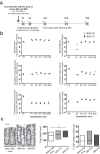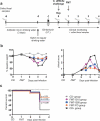Freeze-dried fecal samples are biologically active after long-lasting storage and suited to fecal microbiota transplantation in a preclinical murine model of Clostridioides difficile infection
- PMID: 32501140
- PMCID: PMC7524285
- DOI: 10.1080/19490976.2020.1759489
Freeze-dried fecal samples are biologically active after long-lasting storage and suited to fecal microbiota transplantation in a preclinical murine model of Clostridioides difficile infection
Abstract
Fecal microbiota transplantation is now recommended for treating recurrent forms of Clostridioides difficile infection. Recent studies have reported protocols using capsules of either frozen or freeze-dried stool allowing oral administration in in- and out-patient settings. However, a central question remains the viability, engraftment, and efficacy of the microbiome over time during storage life. This study shows that both the freeze-drying and freezing procedures for fecal samples allowed preserving viability, short-chain fatty acids concentration, and anti-Clostridioides difficile properties of microbiota without significant alteration after storage for 12 months. Fecal transplantation with freeze-dried microbiota allowed engraftment of microbiota leading to clearance of Clostridioides difficile infection in a preclinical murine model with a survival rate of 70% versus 53-60% in mice treated with frozen inocula, and 20% in the untreated group. Moreover, the freeze-dried powder can be used to fill oral hard capsules using a very low amount (0.5%) of glidant excipient, allowing oral formulation. Altogether, this study showed that freeze-dried inocula can be used for the treatment of Clostridioides difficile infection with long-lasting stability of the fecal microbiota. This formulation facilitates biobanking and allows the use of hard capsules, an essential step to simplify patient access to treatment.
Keywords: Clostridioides difficile; Fecal microbiota transplant; freeze-dried microbiota; frozen microbiota; pre-clinical model.
Figures







Similar articles
-
Durable Long-Term Bacterial Engraftment following Encapsulated Fecal Microbiota Transplantation To Treat Clostridium difficile Infection.mBio. 2019 Jul 23;10(4):e01586-19. doi: 10.1128/mBio.01586-19. mBio. 2019. PMID: 31337728 Free PMC article.
-
Community dynamics drive punctuated engraftment of the fecal microbiome following transplantation using freeze-dried, encapsulated fecal microbiota.Gut Microbes. 2017 May 4;8(3):276-288. doi: 10.1080/19490976.2017.1299310. Epub 2017 Feb 28. Gut Microbes. 2017. PMID: 28282270 Free PMC article.
-
Successful Treatment of Recurrent Clostridioides difficile Infection Using a Novel, Drinkable, Oral Formulation of Fecal Microbiota.Dig Dis Sci. 2024 May;69(5):1778-1784. doi: 10.1007/s10620-024-08351-7. Epub 2024 Mar 8. Dig Dis Sci. 2024. PMID: 38457115
-
Immunological mechanisms of fecal microbiota transplantation in recurrent Clostridioides difficile infection.World J Gastroenterol. 2022 Sep 7;28(33):4762-4772. doi: 10.3748/wjg.v28.i33.4762. World J Gastroenterol. 2022. PMID: 36156924 Free PMC article. Review.
-
Effectiveness of fecal microbiota transplant for the treatment of Clostridioides difficile diarrhea: a systematic review and meta-analysis.Lett Appl Microbiol. 2021 Aug;73(2):149-158. doi: 10.1111/lam.13486. Epub 2021 May 8. Lett Appl Microbiol. 2021. PMID: 33864273
Cited by
-
Fecal Microbiota Transplantation Shows Marked Shifts in the Multi-Omic Profiles of Porcine Post-weaning Diarrhea.Front Microbiol. 2021 Feb 23;12:619460. doi: 10.3389/fmicb.2021.619460. eCollection 2021. Front Microbiol. 2021. PMID: 33708182 Free PMC article.
-
Synergy between Lactobacillus murinus and anti-PcrV antibody delivered in the airways to boost protection against Pseudomonas aeruginosa.Mol Ther Methods Clin Dev. 2024 Aug 30;32(4):101330. doi: 10.1016/j.omtm.2024.101330. eCollection 2024 Dec 12. Mol Ther Methods Clin Dev. 2024. PMID: 39314638 Free PMC article.
-
New Procedure to Maintain Fecal Microbiota in a Dry Matrix Ready to Encapsulate.Front Cell Infect Microbiol. 2022 Jun 10;12:899257. doi: 10.3389/fcimb.2022.899257. eCollection 2022. Front Cell Infect Microbiol. 2022. PMID: 35755849 Free PMC article.
-
Next Generation Fecal Microbiota Transplantation.Clin Endosc. 2021 Mar;54(2):152-156. doi: 10.5946/ce.2021.053. Epub 2021 Mar 24. Clin Endosc. 2021. PMID: 33761228 Free PMC article.
-
Prolonged storage reduces viability of Peptacetobacter (Clostridium) hiranonis and core intestinal bacteria in fecal microbiota transplantation preparations for dogs.Front Microbiol. 2025 Jan 7;15:1502452. doi: 10.3389/fmicb.2024.1502452. eCollection 2024. Front Microbiol. 2025. PMID: 39839105 Free PMC article.
References
-
- Kelly CR, Khoruts A, Staley C, Sadowsky MJ, Abd M, Alani M, Bakow B, Curran P, McKenney J, Tisch A, et al. Effect of fecal microbiota transplantation on recurrence in multiply recurrent Clostridium difficile infection: a randomized trial. Ann Intern Med. 2016;165:609–616. doi:10.7326/M16-0271. - DOI - PMC - PubMed
-
- Lee CH, Steiner T, Petrof EO, Smieja M, Roscoe D, Nematallah A, Weese JS, Collins S, Moayyedi P, Crowther M, et al. Frozen vs fresh fecal microbiota transplantation and clinical resolution of diarrhea in patients with recurrent Clostridium difficile infection: a randomized clinical trial. JAMA. 2016;315:142–149. doi:10.1001/jama.2015.18098. - DOI - PubMed
Publication types
MeSH terms
Substances
LinkOut - more resources
Full Text Sources
Medical
Molecular Biology Databases
